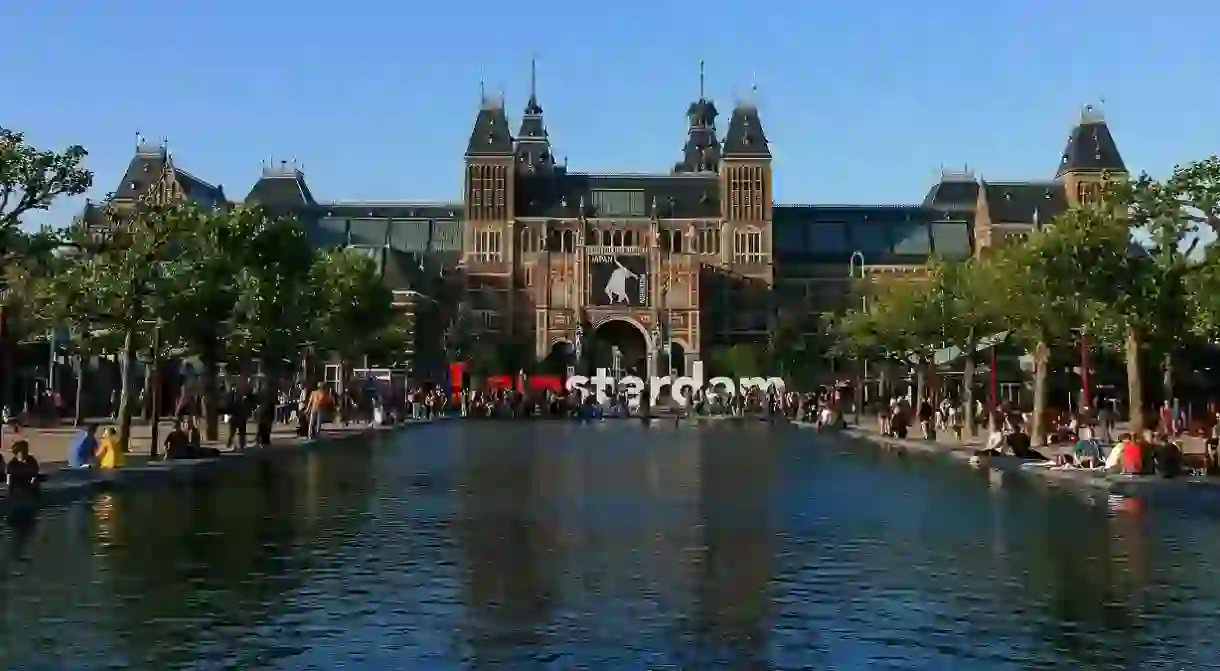The Rijksmuseum In 10 Artworks

The Rijksmuseum houses over one million artworks and can display upwards of 8,000 pieces at one time. This vast collection contains many masterpieces created by preeminent historical figures and includes work by Rembrandt, Vermeer, and Van Gogh. The museum also displays work from lesser known artists whose oeuvre has had significant influence upon Dutch and European culture. To help plan your trip to the Rijksmuseum we’ve curated a list of its must-see artworks.
‘The Night Watch’ — Rembrandt van Rijn, 1642
‘The Night Watch’ is the most famous painting to have been created during the Dutch Golden Age and its importance cannot be overstated. The work was commissioned by Amsterdam’s civic guard and depicts the militia inspecting their weapons before their nightly patrol. Rembrandt was a master of tenebrism and was able to draw out the guard’s anticipation by layering light and shadows. The painting’s colossal size means that it takes up a whole room in the Rijksmuseum.

‘The Milkmaid’ — Johannes Vermeer, 1660
Johannes Vermeer was fascinated by domestic life and many of his paintings deftly capture daily, seemingly mundane activities that represent the social divisions of his time. ‘The Milkmaid’ shows a sturdily built female servant working in a kitchen. She pours milk into a bowl surrounded by stale bread, suggesting that she is preparing a savory pudding. This painting is one Vermeer’s most expressive, using a deep palate that brings out his subject’s humble surroundings.

‘Self-Portrait’ — Vincent Van Gogh, 1887
Van Gogh was heavily influenced by French impressionism and spent several years in Paris working alongside the masters of this movement. This self-portrait is representative of Van Gogh’s time in Paris, illustrating his changing style. Emulating Gauguin and Monet, Van Gogh uses deep, rhythmic brushstrokes to depict his own face, and preferred to create self-portraits as he couldn’t afford a live model.

‘Diorama of a Slave Dance’ — Gerrit Schouten, 1830
Gerrit Schouten was a self-taught Surinamese artist whose work vividly depicted colonial life. His principle1 medium was dioramas; he created miniature models of individuals and communities that were contained within three-dimensional landscapes. This diorama shows slave workers performing a dance and playing music. Every figure in the scene is a slave and the diorama captures the conditions endured by people forced to live on plantations.

‘Christ Preaching’ — Rembrandt van Rijn, 1650-1654
Although Rembrandt is principally known for his large paintings, he was also an exceptionally talented etcher. His ability to express human subjects through light and shadows translated perfectly into this medium. This etching depicts Jesus preaching to a crowd of disciples, some of which are entranced by his words, whereas others are clearly skeptical and showing signs of distrust and impatience.

‘Worship of the Golden Calf’ — Lucas van Leyden, 1530
Van Leyden was one of the main figures to emerge during the Dutch renaissance, and his work embodies many of the themes associated with this cultural period. ‘Worship of the Golden Calf’ is triptych by the artist that follows the Israelites fall from grace during Moses’ absence. Its three panels show the Israelites indulging in numerous sins whilst worshiping the eponymous golden totem. Like other painters of the time, Leyden portrayed historic characters in contemporary clothes and probably chose this narrative because of the growing protestantism in his homeland which forbade the veneration of religious icons.

‘Morning Ride Along the Beach’ — Anton Mauve, 1876
This painting is rightly considered Anton Mauve’s masterpiece. The artist was a leading member of the Hague school and was known for his honest portrayals of the agrarian peasantry. In this painting Mauve shifted his focus to the bourgeoisie, creating a landscape that accentuates the wealth of the social class and their leisured lifestyle. Three riders in fine clothing descend onto a beach, looking onwards to the sea. Their tone is noticeably sombre and clashes with the earthy colors of coastline, symbolizing their detachment from this rural setting.

‘The Battle of Waterloo’ — Jan Willem Pieneman, 1824
This canvas portrays the moment when The Duke of Wellington received the message that the Prussian army were coming to his aid. The sun shines directly onto the commander as his men at arms rejoice. At the bottom left corner of the painting the Dutch crown prince, William II, lies wounded on a stretcher. While the painting was originally created for Wellington, it eventually passed into William II’s possession.

‘Winter Landscape with Ice Skaters’ — Hendrick Avercamp, 1608
Hendrick Avercamp was a master of aerial perspectives and this panoramic piece demonstrates his ability to communicate numerous stories through landscape painting. A whole village is out on the ice and all rings of society are present, with the higher estates enjoying their time outside whilst the peasantry continue to work under this harsh climate. Each figure is meticulously painted and Avercamp magnificently captures a wide range of personalities and activities.

‘The Square Man’ — Karel Appel, 1951
Karel Appel was one of the founders of the COBRA movement and was at the forefront of the European avant-garde. Like his contemporaries, Appel fused spiritual, primitive motifs with a playful aesthetic that ironically reproduced haunting aspects of the human psyche. This picture depicts an exaggerated male figure who stares bemusedly from the frame. The man’s oversized head burdens his childlike body and he appears to be physically and emotionally paralyzed.













